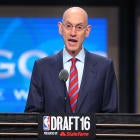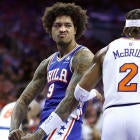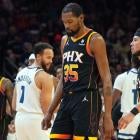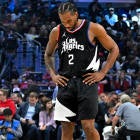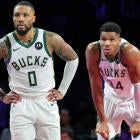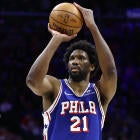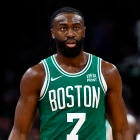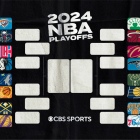It's safe to say it at this point. Forget about black cats, ladders or knocking on wood. There will be a new CBA between the NBA and the NBPA, well ahead of December's opt-out date.
There will be no NBA lockout in 2017.
Yahoo Sports reports the two sides are "on the cusp" of a new deal with only small issues left to hash out. A deal could be announced at any time, and that means there will be no work stoppage for the duration of the new deal. Here's a look at the particulars in the latest Yahoo report:
The NBA will raise rookie-scale, veteran minimum and free-agent exception deals in the new agreement, league sources said. Rises in those salaries could come in the 50 percent range over current numbers, sources said.
The NBA will keep its "one-and-done" rule with college basketball, retreating on its original desire to make college players wait two years after high school graduation to become eligible for the NBA draft, league sources said. Two-way contracts between the NBA and NBA Development League will offer teams the chance to add 16th and 17th roster spots, and pay players differently based upon their assignments in either the league's minor league or as part of the parent team, league sources said.
Source: Sources: NBA, players association close to new CBA.
Here's what this actually means for fans:
1. Players still have to go to college for a year, but can bail after. This is a major concession by Adam Silver, who has been on the warpath touting the need for an extension of the age limit since he took over as commissioner. He has said repeatedly that the league needed a move back to 20 and two years in college, which would have dramatically altered what kind of talent enters the league in terms of their development stage, but also would have prevented players -- some of whom desperately need the money for their families -- from starting their careers as early as they can. Keeping the age limit in place shows a willingness from Silver and the league to bend on key issues in order to keep harmony.
2. The concessions listed above are a reflection of the rise of league income with the new media deal. Contracts are handed out based on a percentage of the cap, but things like the veteran deals and rookie contracts were flat numbers. This number was representative under the old deal but the new financial reality means those numbers are no longer in line with what players will be paid.

Of course, this is going to result in some rookies coming in making more money than certain veterans who signed their deals under the old CBA, and that's going to be awkward, but it'll get sorted out over time and the equilibrium will reset itself. In the short term, however? Think of it this way. The No.1 pick in 2017 will could make as much as $2 million more than Celtics guard Isaiah Thomas will next season. It's one thing when Reggie Jackson or Mike Conley get bigger deals than superstar players. It's another when the fourth or fifth pick is making more. That's going to be tough.
The veteran deals mean that it's no longer pennies for a vet to take a ring-chasing deal, and that helps. It doesn't change the ability of super-contenders like the Warriors or Cavaliers to sign guys to those deals even if they're over the cap, but it pays those guys more to market value.
3. The D-League stuff is a huge deal. It opens the door for the league to become a true minor league, and for teams to invest long-term in players on development plans without shuttling them on and off rosters, and keeps them from going overseas because they need the money.
You can expect with this move for every team in the league to either buy or invest in a one-to-one relationship with a D-League team. Currently, 21 of 30 teams already do so, this should push the rest over. It means that you can draft projects in the second round and really have a plan for their long-term development. It also could see better salaries for players not on NBA contract, which will strengthen the league. The NBA looks finally ready to invest in a true minor league.
4. There will be no amnesties, likely. ESPN reports that there isn't enough ownership support to go after such a provision. This is big because of the contracts handed out this summer. Many, like Conley's "biggest in league history" deal were based on what the market yielded for max players with the new media money influx, but even factoring that, there were contracts that simply wowed other NBA executives. Some of these deals are going to turn out as lemons, a product of the euphoria in the wake of all that money being available. Teams are going to have to live with those deals, and it prevents a "get out of jail free" card for bad decisions.
5. Keeping guys coming off rookie deals is going to be tougher. ESPN also reported this bit:
Restricted free agents also will be able to agree to offer sheets with teams starting on July 1 instead of waiting until July 7. The window for teams to match these offer sheets will be reduced from 72 hours to 48 hours.
Also, teams will no longer be able to pull qualifying offers to restricted free agents, as is currently allowed before July 31.
Source: NBA's amnesty clause on chopping block in CBA talks.
That window has allowed teams time to make other moves, which removed the leverage of those restricted free agents. Now, teams can take a shot on July 1 to put pressure on a team that may be chasing another free agent. Teams will have to choose between the two in many cases. You can still re-sign a player in restricted free agent and go over the cap to do so, but it's going to be tougher when factoring luxury tax an roster plans to maintain those restricted free agents as backup plans. That's a win for the union.
6. The union is taking margin victories over a fight about prior concessions. The basketball-related income split will remain 50-50, which means the union isn't waging a battle over what they gave up in 2011, and the owners are satisfied with the glut of money they've made in the last five years to not want further concessions. The owners get to keep making money hand over fist in a system that benefits them and the players make up some of the losses with deals like the over-36 rule and the veteran minimum changes.
This deal, as it looks to be constructed, also helps both middle-class and star players. There was concern over the newly-star-studded executive board might not do well by the rest of the constituency, but instead President Chris Paul has seemed to have found a middle ground. Younger players make more coming in, veterans get more on their last deals, and star older players like himself can sign longer deals. Under the old CBA, Paul could not sign a five-year max because of the age-36 rule. Now, with that extended to 38, he has room to sign a bigger deal.
7. A bunch of non-millionaires have their jobs saved by this. When the league went to lockout last time out, the league office and team laid off hundreds of employees as "cost-cutting" measures. Some were employees who had worked in their position for decades. Some media outlets laid off employees or placed them on furlough due to an absence of games to cover. There was collateral damage from that lockout. That's avoided, and those are people who had nothing to do with the battle between billionaire owners and players on guaranteed multimillion contracts. The two sides coming together on a deal this early means good things for more than just players, owners and fans.













